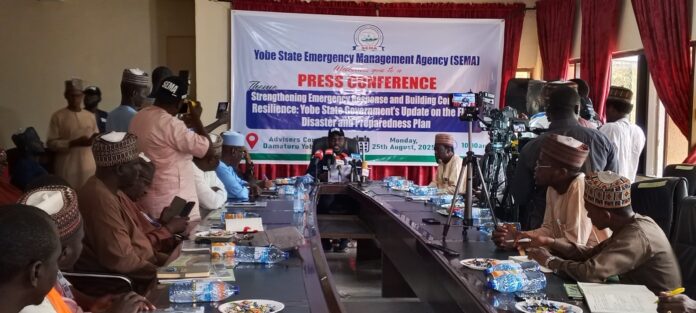By Sani Gazas Chinade Damaturu
Yobe State Government says it has rolled out a comprehensive preparedness plan to strengthen emergency response and build community resilience against flooding across the state.
Dr Goje Mohammed, Executive Secretary of Yobe State Emergency Management Agency (SEMA), disclosed this on Monday at a press conference in Damaturu.
He said the briefing, with the theme “Strengthening Emergency Response and Building Community Resilience: Yobe State Government’s Update on the Flood Disaster Response and Preparedness Plan,” was aimed at updating stakeholders on the state’s interventions.
Mohammed said under the leadership of Gov. Mai Mala Buni, the state government had placed disaster response and resilience-building at the core of its development priorities.
He explained that the governor had consistently mobilised resources on time to ensure life-saving interventions were never delayed during emergencies, earning commendation from partners and communities.
The official recalled that in August, flash floods in Potiskum and Nangere local government areas displaced thousands of residents, but prompt intervention by SEMA and its partners provided relief materials, temporary shelters, food, safe water and medical support.
“These responses send a clear message: under the leadership of Governor Mai Mala Buni, Yobe State Government is proactive, coordinated, and people-centered in its disaster management approach,” Mohammed said.
He commended ministries, departments, agencies, humanitarian partners, community volunteers and traditional leaders for their role in ensuring timely and inclusive interventions.
On the state’s 2025 preparedness plan, Mohammed said the strategy targeted 126,000 households across high-risk LGAs, with contingency arrangements for about 15,967 potentially displaced persons.
He listed the key features of the plan to include deployment of real-time river flow monitoring, community sensitisation, training of local response teams, provision of sandbags for embankment, prepositioning of relief materials and development of contingency plans for 10 LGAs.
He added that the plan also incorporated innovative awareness programmes such as the “Kick Flood” campaign using football to engage youth on disaster preparedness.
Mohammed urged federal agencies, development partners, humanitarian organisations, civil society groups and the private sector to align their support with the state contingency plan to maximise impact.
“By standing united and pooling our resources, we can not only respond effectively when disasters strike, but also build the resilience of our communities for a safer and more secure future,” he said.
The executive secretary called on residents of the state to remain vigilant, heed early warning advisories and work closely with the government to mitigate the impact of floods.




